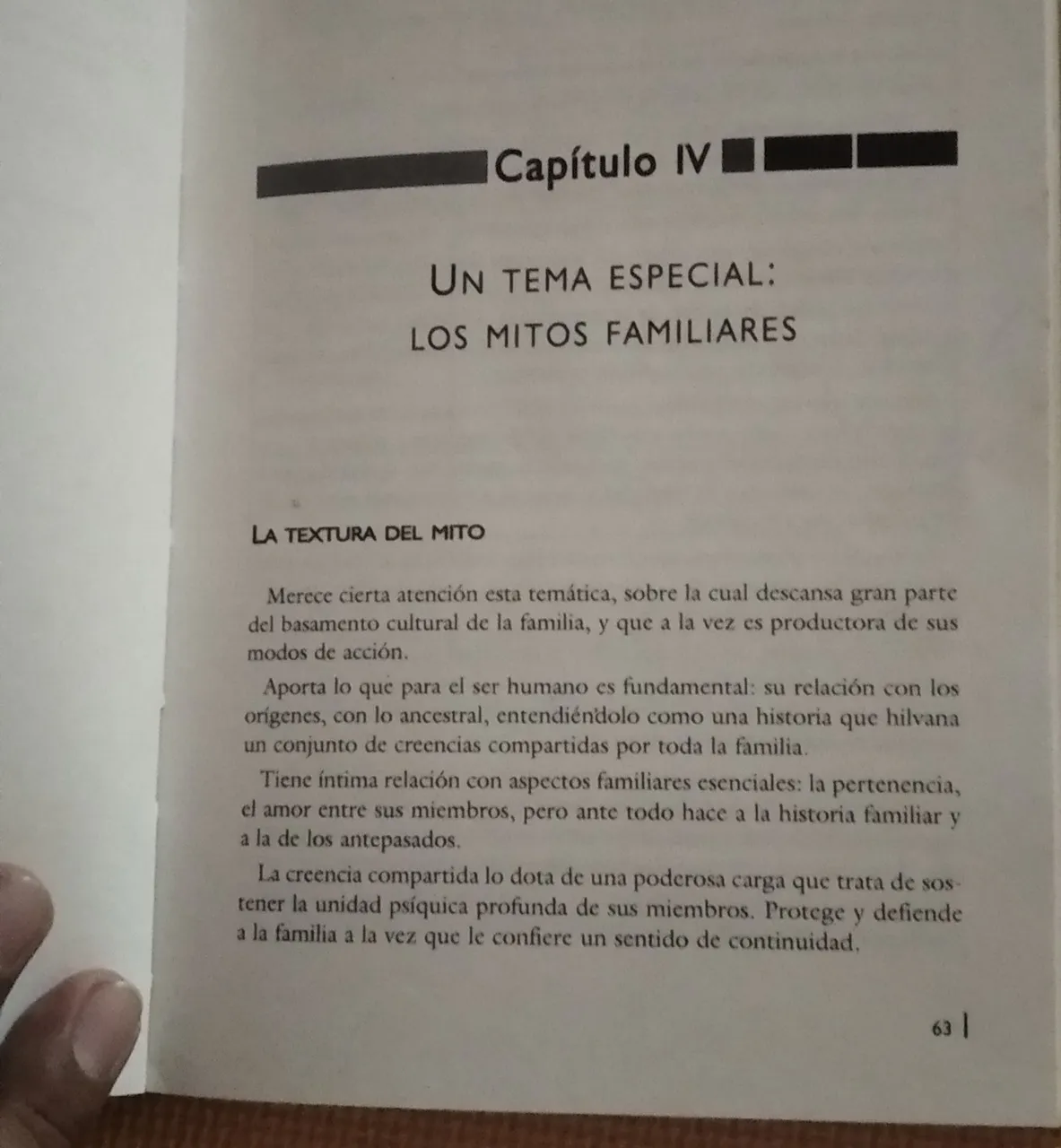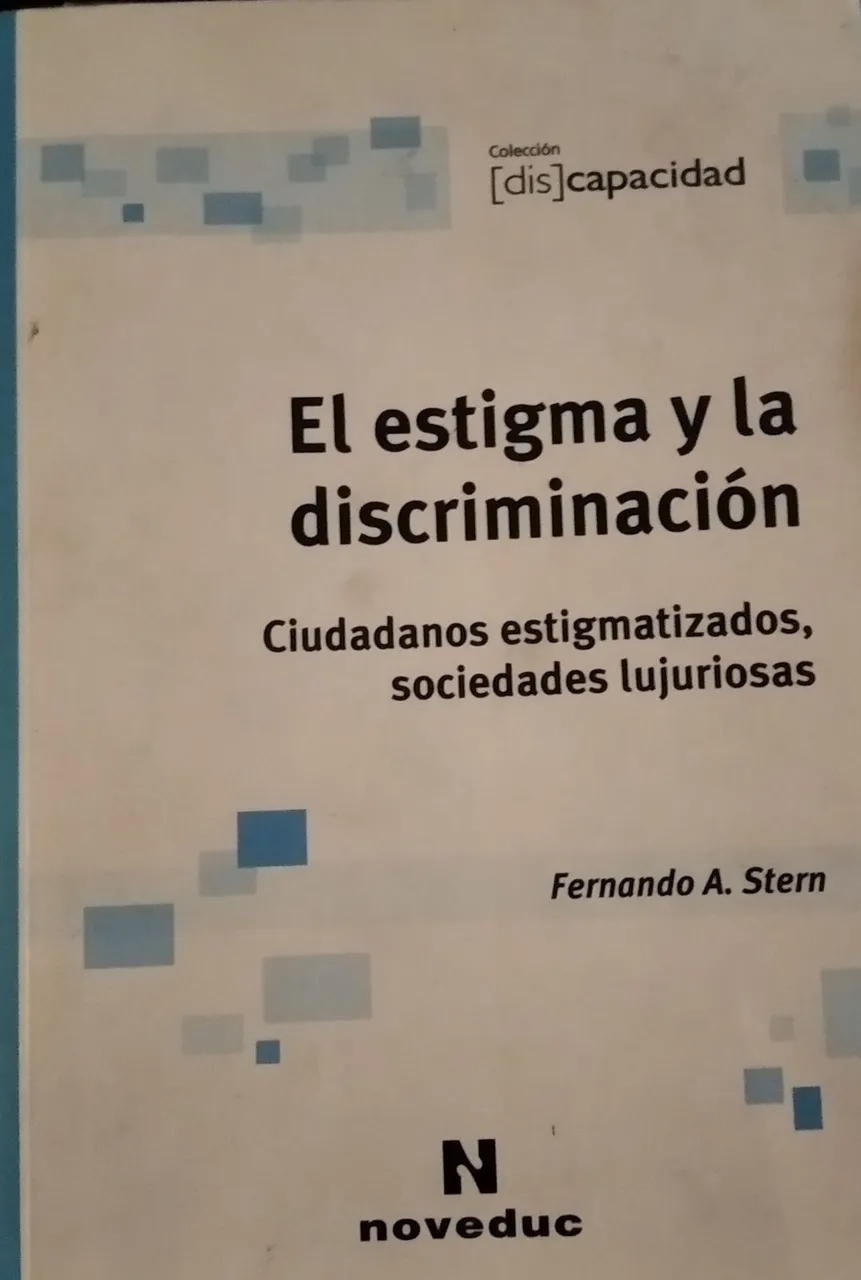El Estigma y la Discriminación
El Estigma y la Discriminación
Ciudadanos estigmatizados, sociedades lujuriosas.
Durante estos días, mientras atravesaba una difícil situación por la inesperada partida de un cercano familiar, dediqué una parte de mi tiempo a la lectura, entre los títulos que llamaron mi atención, se encuentra este libro que a pesar de tratar un tema bastante complejo, me resultó de muy accesible abordaje y me ha dejado un concepto mucho más claro sobre el tema de la familia, de su funcionamiento y de algunos aspectos que inevitablemente influyen en su estructura y cómo a su vez, esta puede afectarnos. Les hablo del libro "El Estigma y la Discriminación" del especialista Argentino Dr. Fernando Stern, perteneciente a la colección (dis) capacidad, en su primera Edición. Centro de publicaciones educativas y material didáctico 2005.
Buenos Aires - Argentina.
Stigma and Discrimination
Stigmatised citizens, lustful societies.
During these days, while I was going through a difficult situation due to the unexpected departure of a close family member, I devoted some of my time to reading. Among the titles that caught my attention was this book which, despite dealing with a rather complex subject, was very accessible to me and has left me with a much clearer concept on the subject of the family, how it works and some aspects that inevitably influence its structure and how it can affect us. I am talking about the book "El Estigma y la Discriminación" by the Argentinian specialist Dr. Fernando Stern, which belongs to the (dis) capacidad collection, in its first edition. Centro de publicaciones educativas y material didáctico 2005.
Buenos Aires - Argentina.

Al hacer referencia a la extraña posición del ser humano de buscar ser el centro de atracción, casi como por efecto natural, también se especifica los diversos argumentos por los cuales al individuo se le hace casi imposible desligarse de su origen, de su grupo universal y de la norma familiar.
La familia es nuestro punto de partida, es nuestro lugar y nuestro origen. De allí derivan los rasgos, el parecido y los patrones de comparación. Sin embargo la familia trasciende lo genético, lo antropológico y se centra en el parentesco para luego enfocarse en construir tu propio núcleo.
Así que, elegir a la familia como punto de partida y como referencia obligada no es casualidad, no es una elección, es un hecho tangible y los expertos que participan en esta obra aseguran que el ser humano inevitablemente, en un momento de su vida, retorna a ella, para encontrar nuevamente su identidad, darle sentido a su historia y posteriormente darle continuidad a esta, con su reproducción, con su prole.
By referring to the strange position of the human being of seeking to be the centre of attraction, almost as if by natural effect, the various arguments are also specified by which it is almost impossible for the individual to detach himself from his origin, his universal group and the family norm.
The family is our starting point, our place and our origin. It is where we derive our traits, resemblance and patterns of comparison. However, family transcends the genetic, the anthropological and focuses on kinship and then focuses on building your own nucleus.
So, choosing the family as a starting point and as an obligatory reference is not by chance, it is not a choice, it is a tangible fact and the experts who participate in this work assure that the human being inevitably, at some point in his life, returns to it, to find his identity again, to give meaning to his history and later to give continuity to it, with his reproduction, with his offspring.



Este interesante libro nos habla de la relación que existe en esa línea fronteriza imaginaria entre la patología y la discapacidad como eje central enfocado en las categorías de sano y enfermo, normalidad y anormalidad. Esto como aspecto destacable de percepción por parte de la sociedad, una sociedad cuyos valores morales se han visto disminuidos en cuanto al rango de objetividad necesaria y que en la mayoría de los casos hace falsos e incorrectos juicios sobre los demás.
De allí la necesidad de definir el estigma, como esa condición o bloqueo que afecta a las personas que lo portan, lo cual genera una errada y excluyente categorización por parte de los grupos sociales considerados como “normales” y lo que hace necesario ver esa diferencia desde un enfoque integrador, para dar el justo valor a las personas, sea cual sea su condición de funcionabilidad. En este punto nacen numerosas interrogantes que nos hacen reflexionar sobre el futuro de las familias que estén constituidas por miembros que hayan crecido en condición de calle o hayan sido niños en adopción, ¿Cuáles serían los patrones predominantes en esos casos? Sin duda temas para la internalización.
En respuesta a estas interrogantes nos presenta un capítulo completo a las nuevas construcciones familiares, donde se aborda abiertamente el tema en el contexto actual, donde podremos obtener importantes datos sobre las distintas problemáticas y las posibles caracterizaciones a estas, para abordarlas de manera técnica dado su importancia, sin caer en los mitos familiares que tanto pueden presentar confusión.
This interesting book talks about the relationship that exists on the imaginary borderline between pathology and disability as a central axis focusing on the categories of healthy and sick, normality and abnormality. This is a remarkable aspect of society's perception, a society whose moral values have been diminished in terms of the range of objectivity required and which in most cases makes false and incorrect judgements about others.
Hence the need to define stigma as that condition or blockage that affects the people who carry it, which generates an erroneous and excluding categorisation by the social groups considered as "normal" and which makes it necessary to see this difference from an integrating approach, in order to give the right value to people, whatever their condition of functionality. At this point, many questions arise which make us reflect on the future of families made up of members who have grown up in street conditions or who have been adopted children: what would be the predominant patterns in these cases? Undoubtedly, issues for internalisation.
In response to these questions, we are presented with a complete chapter on the new family constructions, where the subject is openly approached in the current context, where we can obtain important data on the different problems and possible characterisations of these, in order to approach them in a technical way given their importance, without falling into the family myths that can be so confusing.
Nos facilita también, una mirada desde el punto de vista de cada miembro activo dentro del núcleo familiar y ese reacomodo en los momentos decisivos, al enfrentar problemas comunes de diversa complejidad. Y nos va llevando nuevamente al ciclo, niñez, adolescencia, crecimiento, con sus diversas travesías pero vistas bajo un concepto de necesidad de guía, hasta nuevas etapas de independización, unión y creación de nuevos núcleos familiares y su desarrollo. Dando la impresión de que son ciclos largos, cuando en realidad son sumamente cortos y repetitivos, lo que nos da la oportunidad de intervenir solamente para aconsejar, para ofrecer luces, ayuda y apoyo.
It also provides us with a look from the point of view of each active member within the family nucleus and this readjustment at decisive moments, when facing common problems of varying complexity. And it takes us back to the cycle, childhood, adolescence, growth, with its various journeys, but seen under a concept of the need for guidance, until new stages of independence, union and creation of new family nuclei and their development. Giving the impression that these are long cycles, when in reality they are extremely short and repetitive, which gives us the opportunity to intervene only to advise, to offer light, help and support.




De igual manera nos presenta reflexiones sobre la identidad, la pertenencia y presencia de discapacidad en la familia, tocando temas puntuales bajo diversas características y su posible abordaje, en tanto presenta ese concepto de discapacidad como un proceso meramente de percepción social, que con sus cánones cada vez más débiles, busca limitar el desarrollo de esos grupos y en respuesta, éstos se van transformando y evolucionando para sobrellevar las actuales situaciones de globalización, de modismos y de mercantilismo.
It also presents reflections on identity, belonging and the presence of disability in the family, touching on specific issues under different characteristics and their possible approach, while presenting the concept of disability as a process merely of social perception, which with its increasingly weaker canons, seeks to limit the development of these groups and in response, they are transforming and evolving to cope with the current situations of globalisation, idioms and commercialism.
En conclusión, la lectura de temas similares a este, nos ayuda a comprender y asimilar un mundo que parece desconocido y en el cual nos encontramos inmersos, tomando en cuenta que concienciar a cerca de los diversos tipos de discapacidad, nos conlleva a construir un mejor concepto de sociedad en cuanto a integración se refiere.
Recomiendo ampliamente la lectura de este ejemplar que te ayudará al igual que a mí, a visualizar con un mayor criterio, el mundo que nos rodea y nuestro propio núcleo familiar, en vista de que, a lo largo de su contenido nos conceptualiza situaciones que no sabemos definir o que simplemente desconocemos, por lo que es de mucha importancia para la identificación de la situación en que nos encontramos y lo que tenemos alrededor.
In conclusion, the reading of topics similar to this one helps us to understand and assimilate a world that seems unknown and in which we find ourselves immersed, taking into account that raising awareness about the different types of disability, leads us to build a better concept of society in terms of integration.
I highly recommend reading this book, which will help you, like me, to visualise with greater criteria the world around us and our own family nucleus, given that, throughout its content, it conceptualises situations that we do not know how to define or that we simply do not know, which is why it is of great importance for the identification of the situation in which we find ourselves and what we have around us.

Texto traducido en Deepl en su versión gratuita.
Text translated in Deepl in its free version.


